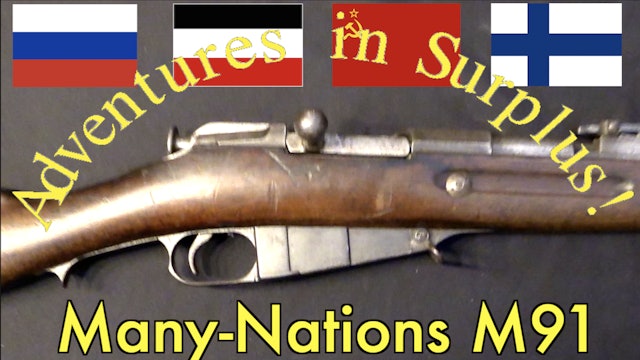-
Romanian 1930s Mosin Carbine Conversion
Romania had more than a million rifles in its inventory after World War One, but they were mused between Mannlicher 88/90, Mannlicher 95, Mosin Nagant, and Berthier patterns - and they were almost all rifles and not carbines. In order to make practical use of all these arms, it was decided to all...
-
Predecessor to the Mosin: the Russian Berdan II
Before adopting the M1891 Mosin-Nagant, the Russian Empire (like most major militaries) used a large-bore single-shot rifle as its standard infantry rifle. In this case, a .42-caliber rifle designed by American General Hiram Berdan (yes, the same guy who invented the Berdan primer). As with other...
-
The Original Shorty Mosin: The Model 1907 Carbine
The creation of a short and handy Mosin Nagant carbine to complement the standard M891 was prompted by the Russo-Japanese War. Lots of Russian troops with roles other than infantry - machine gun and artillery crews in particular - were unnecessarily burdened with full length rifles, and the Model...
-
Kholodovskii: The Greatest Mosin Nagant in History (at Least on Paper...)
The Kholodovskii Mosin was the result of a Russian ordnance project begun in 1912 to improve the M91 Mosin Nagant rifle. Lieutenant-General Nikolai Kholodovskii and the Tula Arsenal were to cooperate to develop rifle that was lighter, more accurate, and more shooter-friendly than the M91. This wo...
-
American Mosin Nagant Rifles
Everyone is aware of the Mosin Nagant rifle, but not everyone realizes that about 2 million of them were actually manufactured in the United States. Russia had been producing M91 Mosin Nagant rifles in their three major arsenals (Tula, Izhevsk, and Sestroyesk) since the mid 1890s, but when World ...
-
St Petersburg Cavalry School Mosin Carbine
This is a rather mysterious - or at least poorly documented - Mosin Nagant carbine variation. Made from an assortment of rifles dated from 1896 through 1920, these carbines were designed to fit Gulkevich folding bayonets. They have a barrel just slightly longer than a 1907 carbine, but were fitte...
-
Mosin-Nagant Factory Pressure Test Rifle
How did people determine chamber pressure in the years before computers and fancy electronics? Well, by squishing a calibrated slug of copper. Factories would convert rifles specifically for pressure testing use by adding a pressure ring around the chamber, drilling a hole in it, and then threadi...
-
Improving Mosins: The Estonian M1935
When Estonia declared independence from Russia in 1918, it had no formal military. After winning a 2-year War of Independence, the nation needed to set up its own armed forces. The rifles available in Estonia were a mix of Mosin Nagants, Arisakas, Pattern 1914 Enfields, and German Mausers. The mo...
-
Mosin 91/30 PU: Soviet Standard WW2 Sniper's Rifle
The Mosin M91/30 PU is the most recognized Soviet sniper rifle of World War Two, but it was not their first. It was preceded by the Model 1931 PE, the Model 1936 PEM, and also the scoped version of the SVT-40 semiautomatic rifle. The SVT was intended to become a universal infantry rifle as well a...
-
Trials Soviet M91/30/43 Mosin - Semin's Folding Bayonet
As World War Two developed, the Soviet Union found that bayonets were frequently lost from its M91/30 Mosin Nagant rifles. The standard bayonet, as adopted all the way back in 1891, was a long spike attached via socket over the muzzle. Carried on the belt is was long and awkward and easily discar...
-
M44L: The Experimental Midlength Folding-Bayonet Mosin Nagant
Courtesy of The Mosin Crate, we have a Soviet "M44L" today. This was an intermediate length (24 inch barrel) pattern of the Mosin Nagant rifle with an M44-style permanently attached folding spike bayonet. Developed in 1944, it was intended to serve as a universal replacement for the Mosin Nagant ...
-
Finnish Mosin Nagant Overview (M91/24, M27, M28, M28/30, M39)
Finland found itself with nearly 200,000 Mosin Nagant rifles in its possession after breaking away from Russian rule in 1917, and those rifles would for the basis of Finnish infantry arms until the adopted of a semiautomatic rifle many decades later.
At first, Russian rifles were simply refurb...
-
Finnish m/27rv Cavalry Carbine
When the Finnish Army adopted the m/27 improved pattern of the Mosin Nagant rifle, there was one group of soldiers who were not really satisfied with it. Finland had a cavalry brigade - one of the elite elements of the force - who wanted something more like the German Kar98AZ carbines they had be...
-
Chrysanthemums in the Snow: Finnish Arisaka Rifles
When Finland took its independence, the most common type of firearms in the country was the Mosin Nagant - and the second most common was the Arisaka. An assortment of Type 30, Type 35, and Type 38 Arisaka rifles and carbines were left to the Finns by former Russian occupying soldiers. Where did ...
-
Adventures in Surplus: An M91 Mosin of Many Flags
Today we are taking a look at an early production M1891 Mosin Nagant rifle. This one has had quite a busy history...it was originally manufactured at the Izhevsk Arsenal in 1894, with several of the features of a very early M91 (like the palm rest on the trigger guard and the sling swivel on the ...
















